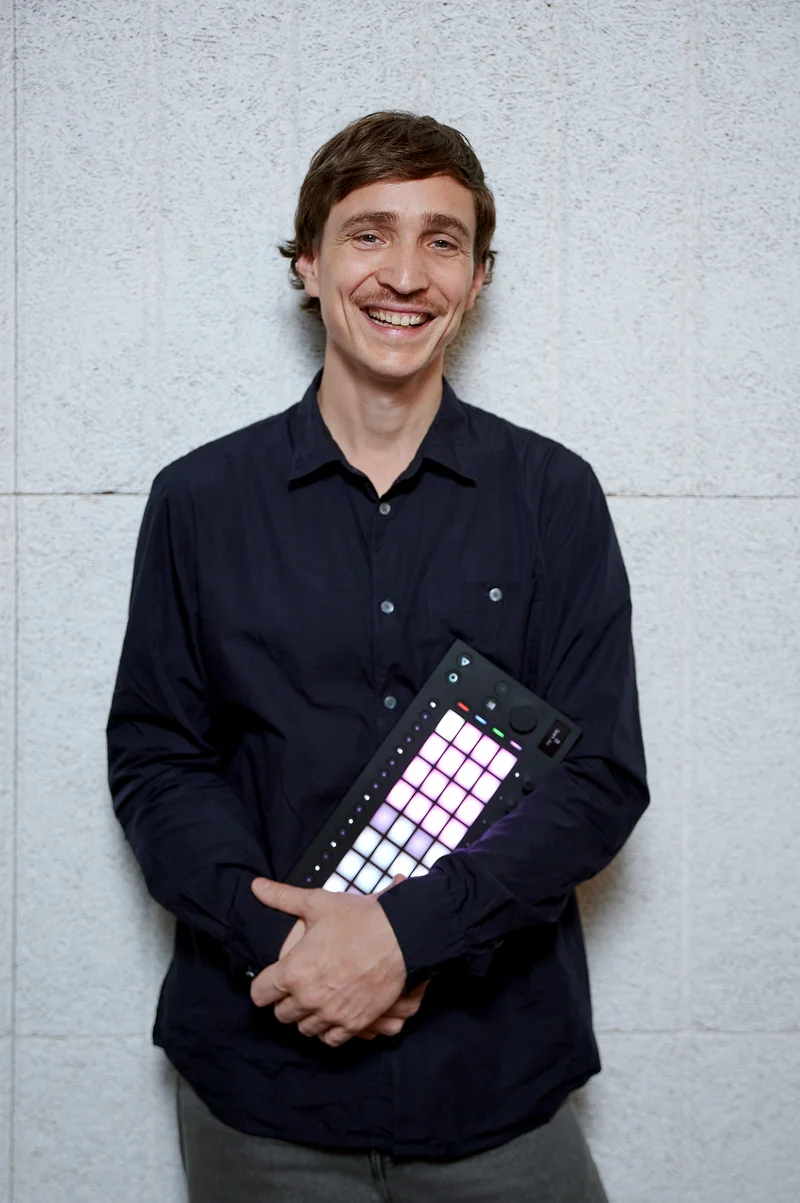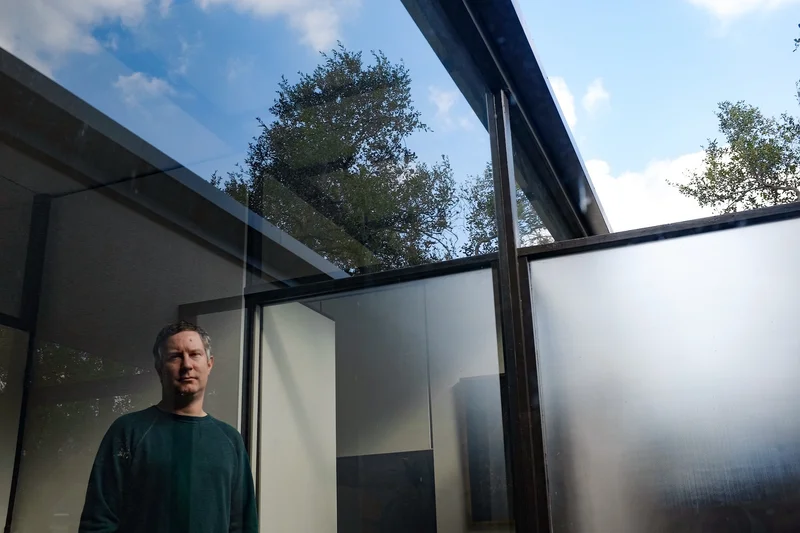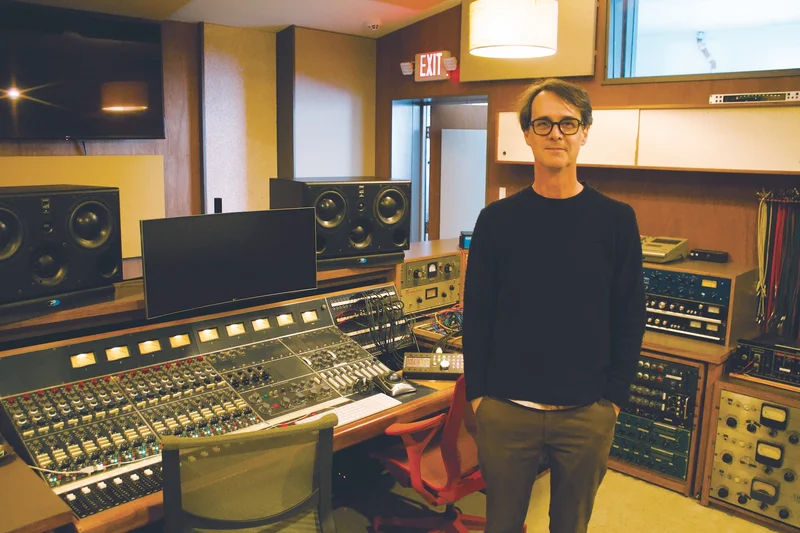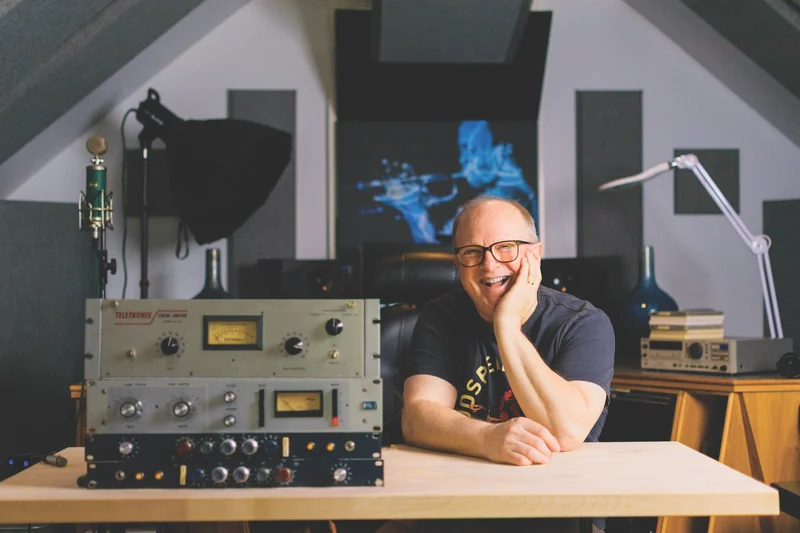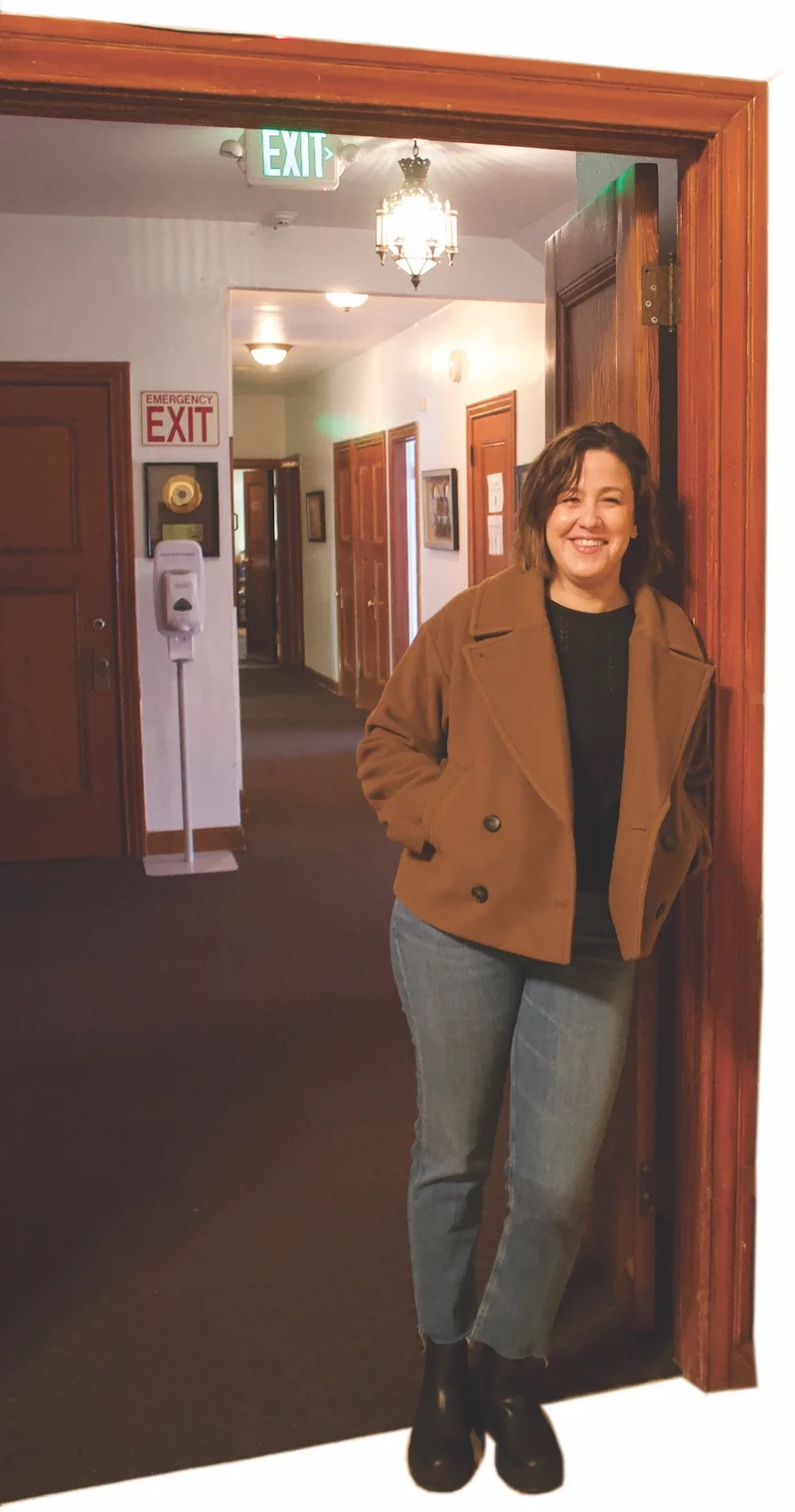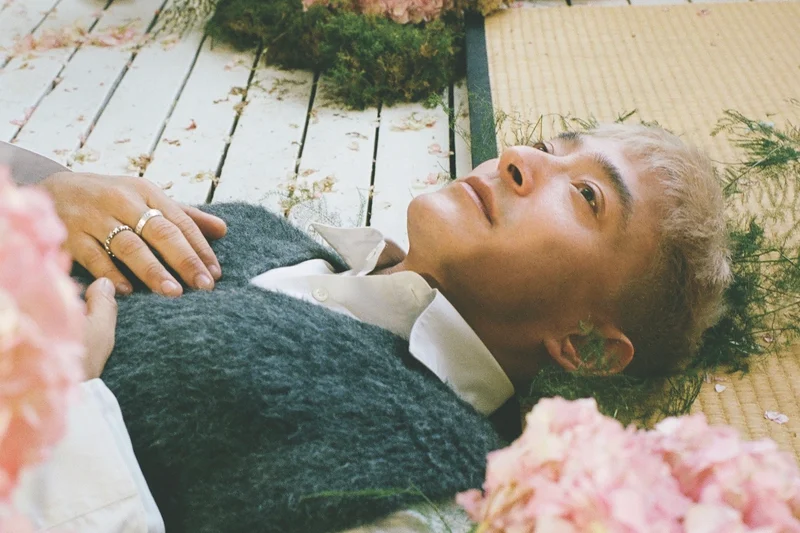Okay, we're taping from this end.
I do love it how we still call it tape.
Even if we're recording an interview via Zoom, we say, "I've got to tape that."
I still do exactly the same thing. I go, "Are we getting this on tape? Is tape running?" It never changes. It doesn't matter if it's all [Avid] Pro Tools or not. "We've got it on tape."
Even the word "analog" means "comparable."
I know. I thought about putting a 24-track back in my studio again for the hell of it. I know that some people do believe in that.
There are two decks here.
[rotates camera]
What are those?

Otari MX-80s.
Otaris, yeah. At my first studio, back in Topanga, I was down 85 steps under the house on a hillside. I dug out, lifted up the house, put in a retaining wall, put the house back down on it, and called that my studio. I had an MCI 24-track and a Soundcraft mixing board, and I was so excited. "I'm in business here." That was my world, for years.
Keeping those running was a pain.
Do you remember the synchronizers, the [Time Line] Lynx [Time Code] Modules?
Yeah. I've got an Adams-Smith Zeta~Three in here. I've never even hooked it up!
Back in the day, that's what we had to use. I reached a point, in the '90s, where it was getting insane. On film scores we had four 24-track [tape decks] going. Then we'd bring in four of these digital multitracks, 8-track units, and we must have had eight Lynx all going. We'd start out a cue, and we'd be watching. Like, "Sync 1, 2, 3, 4, 5, 6… No, come on; god damn it! Cut. We didn't get the last Lynx up."
They'd have to have a lot of pre-roll on tape to get the units to have time to sync.
So much pre-roll. I swear to god, we had to roll a minute before it started to sync up.
There are obviously aspects that none of us miss about that analog world. It's hard to explain to someone who didn't grow up seeing that in action.
It's funny, because when it comes to tracking for a song, I still sometimes miss tape. It's not as big of a luxury as it is in the film score, where we've got 100 tracks going. Being able to stop and start, roll back four bars and pick it up again with an orchestra… oh, my god; that was a game changer. When I'm playing along and hit a mistake, "Okay, cut! Let's roll back to bar 116 and pick it up. There we go. Thank you."

And to be able to easily "see" and know where that is, instead of rewinding and searching around for the bar.
Exactly, exactly. Anyhow, I'm sorry. I already digressed hugely. Apologies.
Oh, no issue! I thought we'd have an easy chat. I co-produced and recorded "Miss Misery" for Elliott Smith for Good Will Hunting. You did the score, and you arranged and co-produced his "Between the Bars (orchestral)" version for the soundtrack.
Sitting with Elliott and Gus [Van Sant, director] in the basement of Gus's house is still one of the great treats I've had. I do remember heading out to see Gus in Boston, [Massachusetts], and he goes, "Look, I know this seems odd, but I'm going to give you a tape. Do you know who Elliott Smith is?" At that point I hadn't been aware of him. He goes, "I think this will be the only artist in the score for songs, and I'd like to get your opinion and soak that up." I listened, and it totally made sense. It was such a rare treat. Usually, songs are dropped in at the end. When I'm scoring, I don't even know what they are until I go to the premiere, because they've changed ten times. Here I was able to take the score and make it go rather seamlessly into the song and back into the score. To try to make it all cohesive was such a pleasure. Of course, Elliott was a pleasure. Later, for the Academy Awards, we were both nominated. Elliott called me one day, and he said, "Danny, I'm at rehearsal, and it's not going well." Bill Conti did an arrangement of the song ["Miss Misery"] for the rehearsal. I could see that was a bad match. I said, "So, when do you need something by?" He said, "By tomorrow." I banged out the arrangement and got him his music by the next day!
He told me you had done the arrangement he sang to during the awards.
Well, I didn't really do anything. It was just the strings. They wanted to have the orchestra play along. Keep it simple and stay out of the way. It was the most basic, simple, easy arrangement, because there was nothing that needed amplification or help. It was really to give it some texture, let it play along, and stay out of the way. Don't try to compete with the song. It was a lovely way to end that process with Elliott, to get called into that emergency orchestration. After 110 films, or whatever it's been, one of the only two times I feel I collaborated with anybody – between the score and the songs – was with Elliott on Good Will Hunting and with Tyler, The Creator on The Grinch. Everything else has been totally separate and removed.
The people who do music placement for film frequently just seem to drop something in.
Yeah, exactly. With Gus, it's all very purposeful. He was already shooting the movie. He had a clear idea, and he was only halfway through the shooting.
Speaking of songs and string arrangements, your new record, Big Mess, is intense! I wouldn't call it a mess, but it is big.
Well, there are 18 songs. By the time I was at eight songs, I already could see what was happening. There was this dichotomy that was coming out. By then, I'd already said, "This is going to be a big mess," because it was going to be two records, written by two different artists, both of whom live inside my head. They don't get along. In fact, they can't stand each other. Laura [Engel], my manager, was saying, "Maybe you should release one of the albums now, and we'll do the other in a year or two." I said, "Laura, in two years I'm not going to want to release any of this. I'm going to be into something else completely." That was the whole frustration of being in a band [Oingo Boingo] for all those years. Every two years I wanted to be in a different band.

Right, right.
I never had a sense of what we were or who I was. Decades later, I finally gave up trying. I don't know if I have an identity or not. If I do, I don't know what it is. It's a big mess in there!
I know you had a Coachella show scheduled before this album that didn't end up happening. Was that the impetus to start writing new vocal-based material?
Yeah. Definitely guitar-based, but with the orchestra. Coachella had been trying to get me to put together an Oingo Boingo reunion for years. I'm so sorry, but it's never going to happen. After Hans Zimmer did an orchestral show at Coachella [in 2017], they wanted to do an orchestra film date. I said, "That still doesn't feel quite right to me." It means playing with a lot of pre-recorded tracks. They cannot mic an orchestra on stage with 30 minutes between sets. It's impossible. Laura brought me out there in 2019. I had written this piece of instrumental music that became the song "Sorry." I wanted it originally to be part of this music festival in Tasmania, called Dark Mofo. It's a great festival. I pitched it as "chamber punk." I said, "I've got an idea for a piece of music with an orchestra and a rock band." I wrote "Sorry" as a 12-minute instrumental. I wasn't singing on it; I was only playing guitar. The only vocals were, "I'm so sorry," by a female choir. The problem was I couldn't put together the rest of a set to go out there and pull it together in 2019. I didn't have time. When I saw Coachella, I said, "Wait a minute, what if it's half film music and half rock band?" I'd revive half a dozen Oingo Boingo tracks that I could still tolerate, and I'd rework them. I'd turn "Sorry" into a song. That's how I approached Coachella. Then it was three months of work, playing with this new band that I was loving being with.
That sounds fun.
It was so inspiring to me, and then it all collapsed. I went into quarantine, like everybody did. I took no film work for 2020, as I had 22 concerts planned. I had concerts for The Nightmare Before Christmas. I had concerts for the Elfman and Burton show [Danny Elfman's Music from the Films of Tim Burton]. I had two world premieres of classical music scheduled. I had Coachella, and we were going to do more shows around that. I'd committed 2020 to concert work. Three months of prep to put together this Coachella show, and nothing. I have a place, not far from Santa Barbara, and I've had it as a second home for many, many years. I've never spent more than a week here. I grabbed my wife, son, and dog, and said, "Let's get out of L.A. for this. It could get nasty." After sitting out here for a month or so, I started working on a classical piece. It was for The Proms, the big classical festival in London, England, in August. They hadn't yet officially canceled. Come April, they announced that nothing was going to happen. That's when I said, "I'm going to write a couple more pieces, just for the hell of it." I was angry, frustrated, and depressed. I had one acoustic guitar, one electric guitar, a handheld microphone, and no headphones. I had my Axe-Fx [amp modeling] rack, so I didn't need a [guitar] amp.
And you started writing?
Yeah, it's a writing room. It's not even a studio. I have my samples, so I could do orchestral work when I'm away from home. I think it's because of Coachella that I had the feel of an electric guitar in my hand. That's why it's a guitar-based album, because it could easily have gone synth-based. At that moment I was feeling the strings still on my fingers, and that became the heart of it. The sound of the band and the orchestra playing together became my center of what I was hearing. That brought me to the direction that the Big Mess went into. Taking on that attitude was due to having been in that mode with a band.
Right. When you're angry, there's nothing better than hitting a guitar. It's very different than playing a keyboard or a synth.
Yeah, exactly right. I let out a lot of aggression with my guitars and vocals. I realized, after my first week, "Fuck the headphones. I'll sing in front of the speakers."

Were those a lot of keeper vocals that you did?
All of them.
You had speaker bleed coming back in on the mic?
Yeah. After about a month I got the headphone amp fixed, and I used them a few times on the soft background vocals. But 95 percent of it was in front of speakers, letting the bleed happen, and not giving a fuck. I made a commitment at the end of it that I was not going to go back in the studio and "fix" these up, which is always how I was wired. I'd cut a demo, go in the studio, get in front of a mic, fix it up, and do multiple takes. When I was doing the vocals for Jack Skellington years ago, I learned to never discount those first demo vocals. At the beginning of The Nightmare Before Christmas, there was no script, and Tim [Burton] and I didn't know how to start. So, we started with the songs. There were ten songs. We went in the studio, and I cut all ten songs in one night. All the vocals for every part except for Sally. I did the big vocals, the little vocals, everything. Cut to six months or a year later, and we were doing the "real" vocals. Now I had orchestra tracks, and it's a whole different thing. Tim kept saying, "Can you bring up the vocals on your demo?" We'd put the demo up, and, for about half of those vocals, I wasn't topping them. We kept them. I tried to EQ them as best as I could to match, and they're in the movie forever. At the end of Big Mess, I was still thinking, "I'll go into my studio in Los Angeles, and I'll get in front of the mic." Then I made a decision. I said, "No, I'm not going to fix anything." I decided, at this point in my life, "What the fuck do I care?" If I'm singing out of tune, I'm singing out of tune. I'm not trying to prove anything. It's 100 percent a handheld mic into Digital Performer, because I don't even use Pro Tools up here. I realized I'm more comfortable holding a mic than I am standing in front of a mic. There are singers who are comfortable standing in front of a mic and singing, but my performing years there was always a microphone in my mouth. Even when I started doing Nightmare… music on stage, I started with in-ear monitors, trying to stand up in front. By the end, I was asking for stage speakers. At a certain point I had to grab it and start walking around.
I saw Oingo Boingo in '83, opening for The Police in Oakland, California. I remember you prowling the stage and moving around a lot. A very visual performer.
Yeah. If I'm not holding a guitar, I have to move.
Right. Did it take any time to get your voice back in shape?
Before Coachella, and before I started doing Jack Skellington [live], I began doing some training to try and bring back my range. When it came time to do Big Mess, I'd already stopped doing that. I had to find a voice, and that was part of the fun of the process. I know what Jack Skellington's voice is, but I don't know what my voice is anymore. I only did one song in the last quarter-century. It was for this movie Wanted, and I cut a song ["The Little Things"] for [director] Timur Bekmambetov. That was it! This was interesting, because I knew from the get-go that I couldn't hit the high notes. I could barely hit the high notes in Oingo Boingo 30 years ago! I always wrote at the top of my range, and it would drive me crazy as soon as I was doing multiple shows. I'd lose my voice every night. This time, it was like, "All right. Don't even think about that. Find something else." I experimented, and when I was singing the song "True," I came away from listening, and I was going, "I'm enjoying this!" I couldn't have sung this song 30 years ago.
As far as the attitude?
For one thing, 30 or 40 years ago I always wanted a rougher voice than I had. It would frustrate me. There was a time when I tried smoking. I hated smoking, but I wanted to rough up my voice. I was almost like a guy in a rock band who's genetically designed to be an Irish tenor singing "Danny Boy" in a bar. I don't know now if it's a combination of my voice having gotten rougher, which it did, but also, I feel freer with it. I can be more raw with my voice now. Back in Oingo Boingo I was aiming for something. I was trying to get it right. I would do multiple takes, try to get a good take, and try to find it. This time I wasn't searching. I was like, "Think about the song and see what voice happens." It's not frustrating at all. In fact, it's fun.
Yeah, the Oingo vocals were more acrobatic. This is emotionally direct.
Yeah, completely. I grew up on R&B singers. I was always trying to do turns with my voice, like R&B singers would do. I never was good at that, but it always drove me crazy. Now I'm not thinking of any of that. I don't give a fuck. It was almost going back to my roots. I was thinking of John Lennon and David Bowie. Who are the singers I really love? Those were two of them. Rather than modeling myself after some cross between Andy Partridge [Tape Op #19] of XTC, any number of R&B singers, and Mark Mothersbaugh from Devo, and somehow creating a hybrid between them, this time I wasn't thinking about it. I was thinking back to my roots. I got into Bowie a lot later, in the '90s. But this one album was huge for me, which was Scary Monsters. That was one of the albums that brought me out of the '70s, where I essentially spent a decade rejecting all contemporary music.
Oh, I love Scary Monsters!
When I came out of the '70s, I didn't know who Bowie was. I discovered Scary Monsters, and my friends are saying, "You idiot! This guy's been around since the late '60s! You've never heard of Ziggy Stardust?" Even my guitar playing still calls back to that album.
The fun, wild parts.
Yeah. For the solo on "True" I didn't want to have to have beautiful guitarists come in and replay it. Most of my guitars on the piece are the ones my engineers, every time we were mixing, they'd note my guitar as the "messy" one. Everything sounded good. Now put mine in, and we'd get some squeals and feedback. Just enough to fuck it up.
That's character!
Occasionally I would hit parts in a certain way, where there's no way to communicate it. "I don't even know how I did this."
Did a lot of the record have to be done one overdub at a time, with the other players?
The whole record. I cut all the demos, and then had to go in one at a time. Josh Freese replaced the sample drums. While Josh had his week, [bassist] Stu Brooks was off quarantining. At the end of Josh's week, Stu finished his two weeks, got tested, and Stu came in and did four days in the studio. While Stu was playing, [guitarist] Robin [Finck] was off quarantining. It was difficult, in that we could never have the pleasure of going into the studio at the same time, with everybody together, but that was the challenge. Fortunately, I'd become used to demoing for films. In the old days of Oingo Boingo, I'd come up with a rough idea for lyrics and chords and play it for the band, and then we'd immediately pick it up.

Rearrange it?
Yeah. There's no reason to overdo a demo [for a band]. A demo was probably just a drumbeat, me playing guitar, and a vocal. Every piece that goes into a film has to be demoed first.
Right, mock-ups.
I did mock-ups for every song, and I'm going to release them soon on my website. I'll put out all the demos, for nerds who are into it.
I was curious about your studio.
The Studio Della Morte.
How many rooms is it?
It's a small room, and the control room is nice. I can work there, and we can mix small shows there. I won't try to mix an ultra-wide show. For that we'll go into the bigger rooms. I do all the small recording there. I have a whole room full of percussion. I've wired up my studio to the front room of the loft, where I have all my percussion. The studio itself is a proper room, with two iso booths. I can have the whole band playing, or I can put eight strings in there. I have a grand piano, a Bösendorfer. We did all the recording for Big Mess there. When I bought it, I had an SSL from the '70s. After three years of never using it, I finally said, "I know one of these days I have to get a fucking Euphonix [console], but I don't want to do that yet." We put in a desk instead, and ten years later it's still there. I never did get the Euphonix, thank god. When first I got the studio, every composer had a Euphonix, and those cost $450,000. I held off and used my [Avid] Artist Mix [controller]. Now I've got the big Artist Mix, the 16-fader one. It's fine! I mix whole shows on that thing. I can't find any reason to put in anything else, at this point.
Do you have a full-time staff?
I take great pride in having the smallest entourage of any composer in Hollywood. I have a staff of two.

Maybe it's easier to manage than something like Hans Zimmer's Remote Control Productions complex.
I've used that as a model. Like, "I'll be the other end of that."
Right. It's not saying one is right or wrong, obviously.
Yeah. I never rent it out. It's just for my use. I don't have the financial pressure to keep it rolling all the time.
Right. I know that feeling!
Yeah. It's a real pressure. I resolved years ago that I'm not good at that. Hans is a great producer and manager. I think a lot of his talent is in managing groups of people and teams. I'm happiest being a lonely guy off in the corner. My one assistant, Melisa McGregor, wears four different hats. She'll be a second engineer assistant. She'll also organize all the music. She can also print out music for smaller sessions; I don't need a music copyist. She does everything. Then I have a tech. He's always working on upgrading the system and keeping my libraries current. It's always very complicated with me, because when I buy a new piece of equipment it's got to get duplicated four times. I have a little studio in my house in L.A. and in my house up north. They have to all be compatible. I have a second print room at my studio. Whenever we're doing films, that room is going all the time. I'm writing, and then as soon as I'm done writing, the tech will be printing for the actual session with the orchestra that's coming up. On my scores, all the synths and all the percussion is me. He's got to set up the Pro Tools session that's going to go onto the big stage.
That's a lot of work!
It's a lot of work in the movies, for sure. There might be 40 cues, and they all have to be laid out in Pro Tools cleanly, with the right tempo map and all my pre-lay [pre-records].
If they're going to an orchestral session, the cost per hour is astronomical.
It's huge. You're absolutely right. We don't want any fuck ups. Everything's got to be perfectly laid out before it gets to that stage. My room looks like it's not much different than your room, size-wise. I've got racks of analog gear that I use. I have Neve racks that we go through. I've got Pultec EQs.
For getting the sounds down, and processing?
Yeah. Even though we're in-the-box in Pro Tools mixing, there's a lot of analog available. Compression, EQ, and whatever else any engineer might want.
It sounds ideal! Thank you so much, Danny. This has been fun to chat.
Oh yeah, totally.

